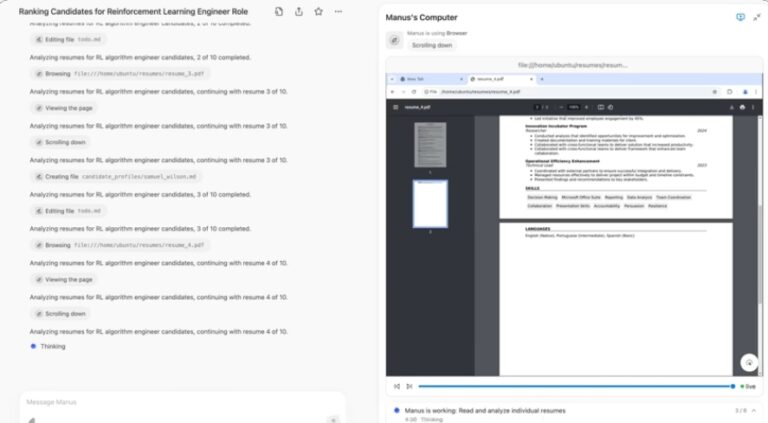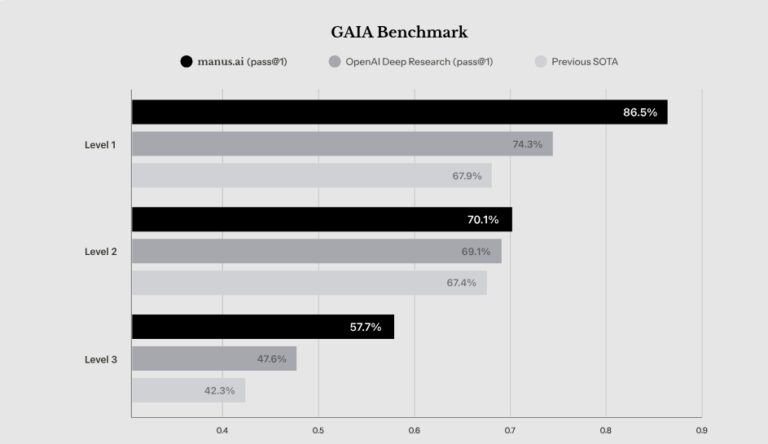In the rapidly evolving global technological market of artificial intelligence, a new paradigm is emerging that goes beyond conventional chatbots and language models. General AI agents represent the next frontier in autonomous digital assistance, and Manus AI stands at the forefront of this revolutionary approach.
The Evolution of AI Assistants: From Chatbots to Autonomous Agents
Traditional AI assistants like early iterations of ChatGPT primarily functioned as sophisticated conversational interfaces. They excelled at generating text, answering questions, and providing information but lacked the ability to independently execute complex, multi-step tasks in real-world scenarios.
Enter Manus AI – a breakthrough general AI agent that fundamentally transforms how we interact with artificial intelligence.
Understanding General AI Agents: Beyond Conversation
A general AI agent differs from conventional AI models in several important ways:
Autonomous Task Execution
Unlike traditional language models that simply respond to prompts, a general AI agent can break down complex objectives into manageable steps and execute them independently. Manus AI can screen résumés, conduct detailed property searches, compile comprehensive professional lists, and even create entire websites with minimal human intervention.
Multi-Model Architecture
What truly sets Manus apart is its innovative multi-model architecture. Rather than relying on a single large language model, Manus integrates multiple AI systems, including Anthropic’s Claude 3.5 Sonnet and customized versions of Alibaba’s open-source Qwen. This approach allows it to leverage different AI strengths depending on the specific demands of each task.
Transparent Decision-Making Process
One of Manus AI’s most distinctive features is its “Manus’s Computer” interface, which provides unprecedented visibility into the agent’s decision-making process. This window allows users to observe the AI’s actions in real-time and intervene when necessary, creating a truly collaborative human-AI workflow.
Real-World Applications: Manus AI in Action
MIT Technology Review conducted extensive hands-on evaluations of Manus AI across diverse tasks:
Comprehensive Research Compilation
When tasked with compiling a list of prominent journalists covering China’s technology sector, Manus demonstrated remarkable adaptability. Although it initially produced a limited list, it quickly responded to feedback by delivering a comprehensive roster of 30 journalists with detailed information about their current outlets and notable work.
Complex Property Search Analysis
Manus efficiently processed complex real estate requirements, including budget constraints, location preferences, and specific amenities. It provided tiered recommendations categorized as “best overall,” “best value,” and “luxury option” – completing the task in under 30 minutes.
Candidate Identification and Evaluation
For the most challenging assignment – identifying potential candidates for MIT Technology Review’s Innovators Under 35 program – Manus developed a sophisticated search strategy. It systematically reviewed selection criteria, scoured university websites, tech award announcements, and news articles to compile recommendations.
The Technical Infrastructure Behind Manus AI
Developed by Chinese startup Butterfly Effect with financial backing from Tencent Holdings, Manus represents China’s most ambitious entry into the emerging AI agent market. The platform’s architecture incorporates several groundbreaking elements:
Strategic Partnerships
Manus has announced a collaborative partnership with Alibaba’s cloud computing division to make its capabilities available on “domestic models and computing platforms.” This alliance coincides with Alibaba’s advancements in foundation model technology, including the release of QwQ-32B, a reasoning model that reportedly achieves performance comparable to OpenAI’s o1-mini with significantly fewer parameters.
Operational Economics
Despite its advanced capabilities, Manus maintains relatively competitive operational costs at approximately $2 per task – significantly lower than similar services. This cost-effectiveness could position it as an attractive option for individual professionals, small teams, and independent developers.
Current Limitations and Future Potential
While Manus demonstrates impressive capabilities, it faces several challenges in its current implementation:
Technical Constraints
MIT Technology Review documented frequent system crashes and timeout errors during extended use, with error messages citing “high service load.” These issues suggest that computational infrastructure remains a limitation, contributing to highly restricted access (less than 1% of waitlisted users have received invite codes).
Access Restrictions
Manus encounters significant obstacles when attempting to access paywalled content or academic papers, often triggering CAPTCHA blocks or being flagged for suspicious activity. Future iterations would benefit from more sophisticated methods for handling these restrictions or proactively requesting human assistance.
The Future of General AI Agents
The emergence of Manus indicates a significant shift in AI development philosophy. Rather than focusing exclusively on improving base models, developers are increasingly exploring how to create truly autonomous agents capable of navigating real-world tasks with minimal human guidance.
This evolution represents more than incremental progress – it signals a fundamental reconsideration of the relationship between humans and artificial intelligence. In this emerging paradigm, AI transitions from a tool that requires constant instruction to a collaborative partner capable of independent action while maintaining human oversight.
As Peak Ji Yichao, co-founder and chief scientist at Butterfly Effect, noted, Manus exemplifies how “Chinese AI companies are not just following in the footsteps of their Western counterparts… they are actively shaping the adoption of autonomous AI agents in their own way.”
Conclusion: A New Era of Human-AI Collaboration
Manus AI represents a significant milestone in the development of artificial intelligence – not merely for its technical achievements but for how it reimagines the relationship between humans and intelligent systems. By combining autonomous execution with transparent processes and collaborative interfaces, it offers a glimpse into a future where AI becomes less a tool and more a partner.
As one MIT Technology Review evaluator described it, working with Manus “feels like collaborating with a highly intelligent and efficient intern.” This assessment captures the essence of what makes general AI agents so transformative – they bridge the gap between theoretical AI capabilities and practical, real-world applications in ways that fundamentally enhance human productivity.
With continued refinement of its infrastructure and capabilities, Manus AI and similar general AI agents may soon become essential collaborators across industries, augmenting human creativity and productivity in ways previously confined to science fiction.
If you are interested in this topic, we suggest you check our articles:
- The Race Toward Artificial General Intelligence
- Generative AI vs Interactive AI: Get to Grips with the Key Differences
- AI Chatbot Assistant for Business – Friend or Foe?
Written by Alius Noreika
Sources: Manus.im, MIT Technology Review, AI News


